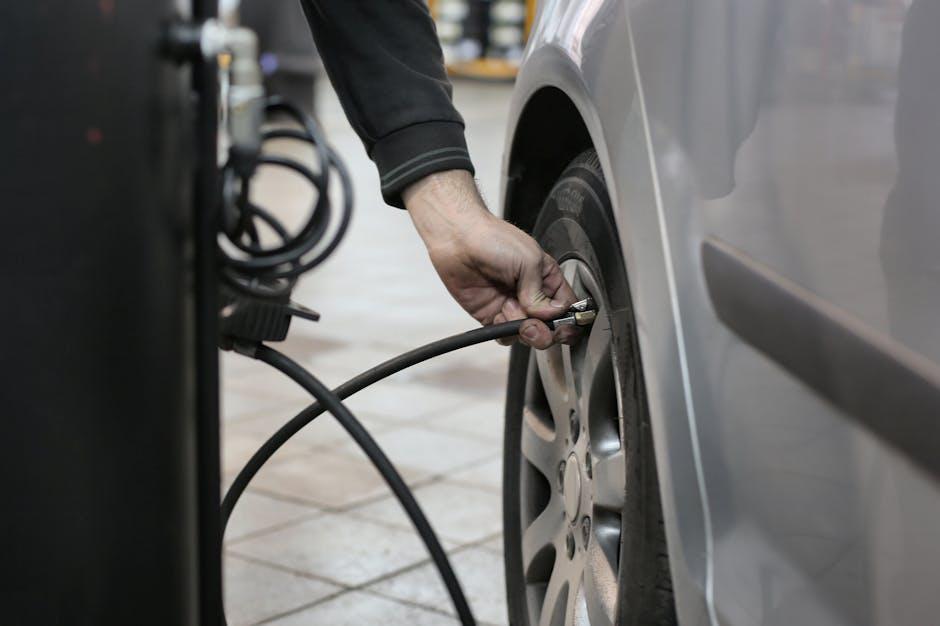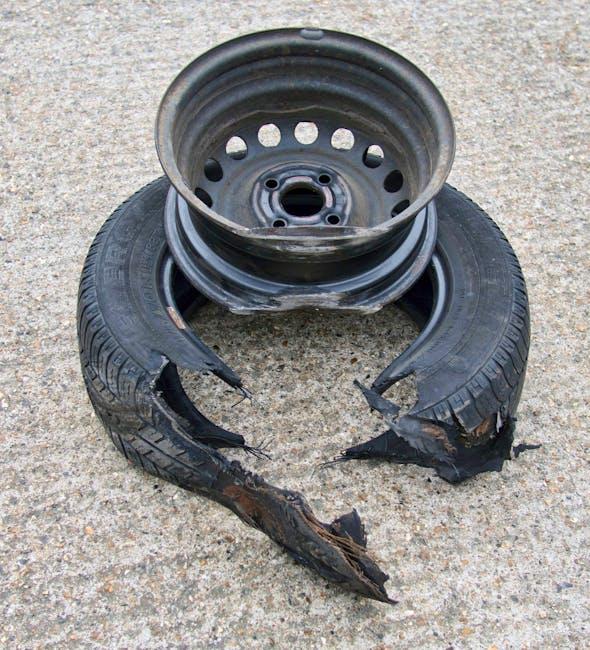There’s something universally unsettling about the sudden hiss of air escaping your tire on an open road. Whether you’re headed to work, embarking on a weekend adventure, or just making a quick stop at the store, a flat tire can throw a wrench in your plans—and leave you stranded in an inconvenient spot. But before panic sets in, remember: fixing a flat tire is a skill you can master with a little know-how and the right tools. In this guide, we’ll walk you through the simple, step-by-step process to get you back on the road swiftly and safely, turning an unexpected setback into a manageable pit stop.
Table of Contents
- Essential Tools You Need Before Tackling a Flat Tire
- Finding a Safe Spot to Pull Over and Park
- Step-by-Step Guide to Loosening and Removing the Flat Tire
- How to Properly Position and Use the Jack for Lifting
- Installing the Spare Tire and Securing Lug Nuts Correctly
- Tips for Driving Safely After Fixing Your Flat Tire on the Road
- Q&A
- The Conclusion

Essential Tools You Need Before Tackling a Flat Tire
Before rolling up your sleeves to change a flat, ensure you have the right arsenal on hand. Having reliable tools not only speeds up the process but also keeps you safe on the roadside. Essential items include a sturdy car jack capable of lifting your vehicle, a lug wrench to loosen and tighten nuts, and a spare tire that’s fully inflated and ready for action. Without these basics, you’ll find yourself stuck and frustrated, turning what should be a quick fix into a roadside nightmare.
Additionally, consider packing a few extras to make the task easier and more comfortable. A pair of work gloves improves grip and protects your hands, while a reflective vest enhances visibility if you’re changing a tire near traffic. A flashlight or headlamp is invaluable for nighttime tire changes. Keep everything organized in a compact carry bag designed specifically for tire tools — this ensures you’re never caught off guard, no matter where your journey takes you.
- Car jack – lifts your vehicle safely
- Lug wrench – removes and tightens lug nuts
- Spare tire – ensure it’s fully inflated
- Work gloves – protect hands and improve grip
- Reflective vest – boosts roadside visibility
- Flashlight/headlamp – essential for low light conditions
| Tool | Purpose | Tip |
|---|---|---|
| Car jack | Lifts vehicle | Check weight limit matches your car |
| Lug wrench | Loosens & Tightens lug nuts | Use cross pattern to secure nuts |
| Spare tire | Replacement wheel | Inspect pressure monthly |
| Work gloves | Hand protection | Comfortable & non-slip |

Finding a Safe Spot to Pull Over and Park
When your tire suddenly goes flat, the first and most crucial step is to find a secure location to stop your vehicle. It’s important to select a spot where you can safely exit the car without interfering with traffic or exposing yourself to unnecessary risks. Look for areas with a wide shoulder, a rest stop, or a parking lot nearby. Avoid stopping on narrow bridges, sharp curves, or busy highways where visibility is low and passing cars may not anticipate a stationary vehicle.
Once you identify a possible spot, consider these key factors:
- Surface Stability: Choose a flat, firm surface to prevent your car from rolling when lifted.
- Visibility: Ensure your vehicle is easily seen by other drivers; use hazard lights to enhance visibility.
- Space: Ample space around your car will enable you to work comfortably and safely change the tire.
- Legal & Safe: Avoid no-parking zones and emergency lanes reserved for official use.

Step-by-Step Guide to Loosening and Removing the Flat Tire
First, ensure your vehicle is parked on a flat, stable surface and engage the parking brake to prevent any movement. Locate your spare tire, jack, and lug wrench—these are usually found in the trunk or under the rear of the vehicle. Before lifting the car, slightly loosen the lug nuts on the flat tire by turning them counterclockwise with the lug wrench. This step is crucial because it’s much easier to break their seal while the tire is still on the ground, where the wheel won’t turn. Remember, apply firm pressure but don’t remove the nuts completely just yet.
Next, position your car jack under the manufacturer’s recommended jacking point, usually indicated in your vehicle’s manual or with markings near the tires. Carefully raise the car until the flat tire is fully off the ground. Now, remove the loosened lug nuts entirely—place them in a safe spot so they don’t get lost. With all nuts off, grab the tire firmly and pull it straight towards you to detach it from the wheel hub. If it’s stuck due to rust or dirt, a gentle wiggle often helps. With the flat tire removed, you’re ready to install your spare and continue your journey safely.

How to Properly Position and Use the Jack for Lifting
Before lifting your vehicle, ensure the car is parked on a flat, stable surface to prevent any accidents. Engage the parking brake and place wheel wedges opposite to the wheel being lifted for extra security. Locate your vehicle’s designated jack points—these are usually marked in your owner’s manual or found near the frame along the car’s side. Positioning the jack correctly is crucial; placing it under these reinforced areas distributes the weight safely and avoids damage to the undercarriage. Once aligned, slowly pump or turn the jack handle to lift the tire off the ground, giving you enough clearance to remove the flat tire.
While operating the jack, keep an eye on the vehicle’s stability—never place any part of your body under the car while it’s elevated. Use a stand jack if possible for added safety. If your jack has multiple height settings, select the lowest one sufficient to lift the tire. Here’s a quick guide to remember the essentials:
- Flat Surface: Always work on solid, level ground to prevent slipping.
- Secure Placement: Use wheel wedges and check jack points carefully.
- Steady Lifting: Raise the car slowly to maintain balance.
- Safety First: Avoid getting under the car and use jack stands if available.

Installing the Spare Tire and Securing Lug Nuts Correctly
Begin by carefully lifting the spare tire onto the hub, ensuring it aligns perfectly with the wheel studs. It’s crucial to position the tire so the holes slide smoothly over each lug nail without forcing it. Once in place, gently press the spare tire towards the hub to keep it steady. This step prepares you to fasten the lug nuts without misalignment, preventing potential damage to the studs.
When securing the lug nuts, avoid tightening any single nut fully at first. Instead, follow a crisscross pattern to evenly distribute pressure, locking the tire firmly. Use your hands initially, then switch to a wrench for a snug fit. Below is a simple guide to the tightening pattern you should follow:
| Order | Nut Position |
|---|---|
| 1 | Top |
| 2 | Bottom opposite |
| 3 | Left |
| 4 | Right opposite |
- Hand-tighten all lug nuts first to avoid cross-threading.
- Use a wrench to secure nuts in the crisscross pattern.
- Double-check all nuts after lowering the car slightly.

Tips for Driving Safely After Fixing Your Flat Tire on the Road
Once your spare tire is securely in place, it’s crucial to proceed with caution. Drive slowly and avoid sudden acceleration or braking to give your temporary tire time to adjust and settle. Remember, most spare tires are designed for short-term use and limited speeds—usually no more than 50 mph—so respecting this limit can prevent further damage or loss of control. Additionally, keep your headlights on even during the day to increase visibility and signal caution to other drivers.
Be vigilant and stay alert for unusual vibrations or noises, as these can indicate that your spare isn’t properly fitted or that other mechanical issues have arisen. Avoid rough roads and sharp turns; smooth, steady driving is key. If you notice any signs of instability, safely pull over and check your tire again. Below is a quick reference guide for maintaining safe speeds based on common spare tire types:
| Spare Tire Type | Recommended Max Speed | Typical Usage Distance |
|---|---|---|
| Temporary “Donut” | 50 mph (80 km/h) | 50-70 miles (80-113 km) |
| Full-Size Spare | Same as regular tire | Unlimited, but check tread & pressure |
| Run-Flat Tire | 50-55 mph (80-88 km/h) | Up to 50 miles (80 km) |
Q&A
Q: What should I do immediately after realizing I have a flat tire on the road?
A: First, stay calm and safely guide your vehicle to the side of the road or a flat, stable area away from traffic. Turn on your hazard lights to alert other drivers, and if available, place reflective triangles or cones behind your car for extra safety.
Q: How do I know if I can change the tire myself or if I need professional help?
A: Assess your comfort level with the task and the tools you have. If you have a spare tire, jack, and lug wrench—and it’s safe—you can change it yourself. Otherwise, calling roadside assistance is the best option to avoid risk or damage.
Q: What essential tools do I need to fix a flat tire on the road?
A: You’ll need a spare tire (properly inflated), a car jack, a lug wrench, and ideally, wheel wedges or blocks to prevent the car from rolling. Some drivers also carry a flashlight, gloves, and a reflective vest for safety.
Q: Could you walk me through the basic steps to change the flat tire?
A: Certainly! Start by loosening the lug nuts slightly before lifting the car with the jack. Then, raise the vehicle until the flat tire is off the ground, fully remove the lug nuts, and take off the flat tire. Replace it with the spare, screw on the lug nuts by hand, lower the car, and then tighten the nuts securely in a star pattern.
Q: What if I only have a tire repair kit or sealant—can that fix the flat on the road?
A: Tire repair kits and sealants can work as temporary solutions for small punctures, allowing you to drive carefully to a nearby repair shop. However, they don’t replace a proper tire change or repair, so use them only as a short-term fix.
Q: How can I prevent getting a flat tire while driving?
A: Keep your tires properly inflated to the manufacturer’s recommended pressure, avoid road hazards like potholes or debris, and regularly inspect your tires for signs of wear or damage. Rotating your tires and checking your alignment can also extend tire life.
Q: What safety tips should I keep in mind when fixing a flat tire on the road?
A: Always choose a safe spot away from heavy traffic, use reflective gear or lights to increase visibility, set the parking brake, and place wheel wedges opposite the flat tire to prevent rolling. Avoid changing a tire on steep inclines or unstable surfaces.
Q: Is it okay to drive on a flat tire to reach a service station?
A: It’s generally not recommended because driving on a flat tire can damage the tire further, the wheel, and your car’s suspension. If it’s absolutely necessary, drive very slowly for a short distance, but it’s safer to change the tire or call for help.
The Conclusion
Fixing a flat tire on the road doesn’t have to turn a smooth journey into a stressful ordeal. With a little preparation, a calm mindset, and the right know-how, you can handle this common setback like a seasoned traveler. Remember, every flat tire is just a small pause in your adventure—a chance to pause, troubleshoot, and get back on the road safely. So next time the unexpected strikes, trust in your skills and keep moving forward with confidence. Safe travels!

